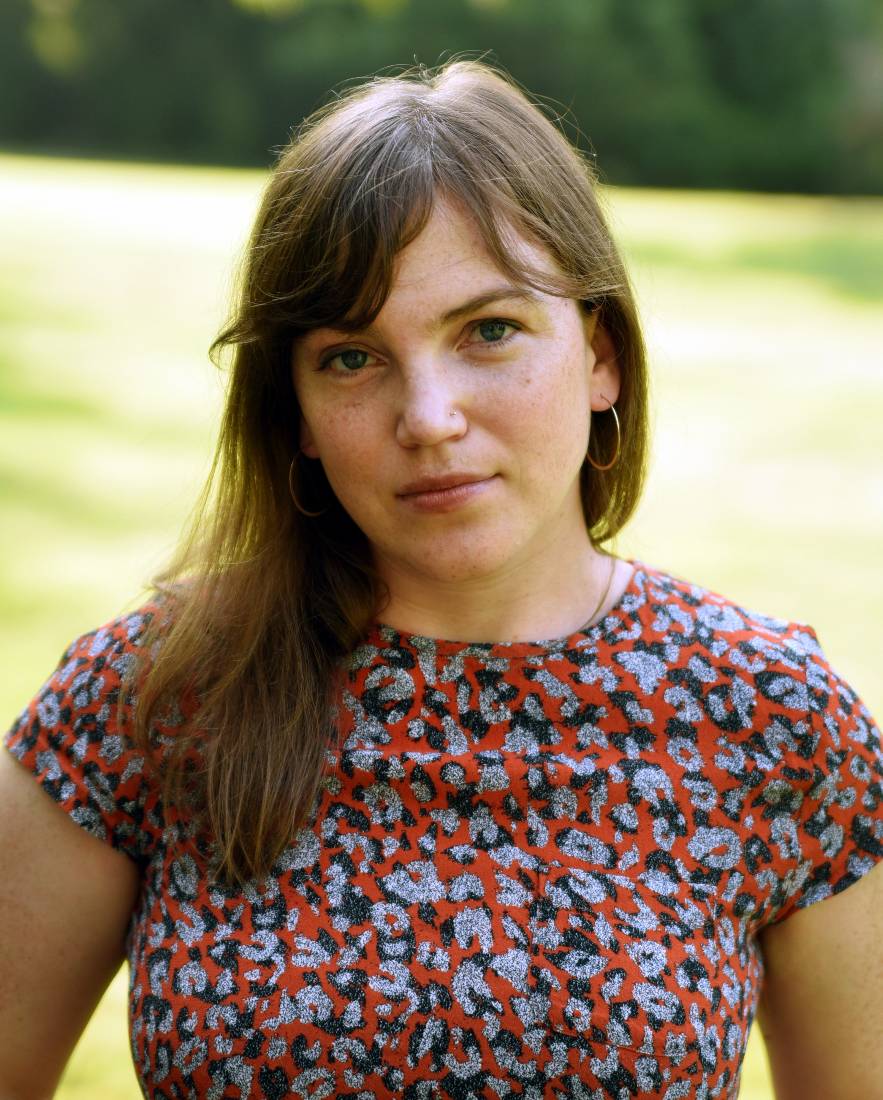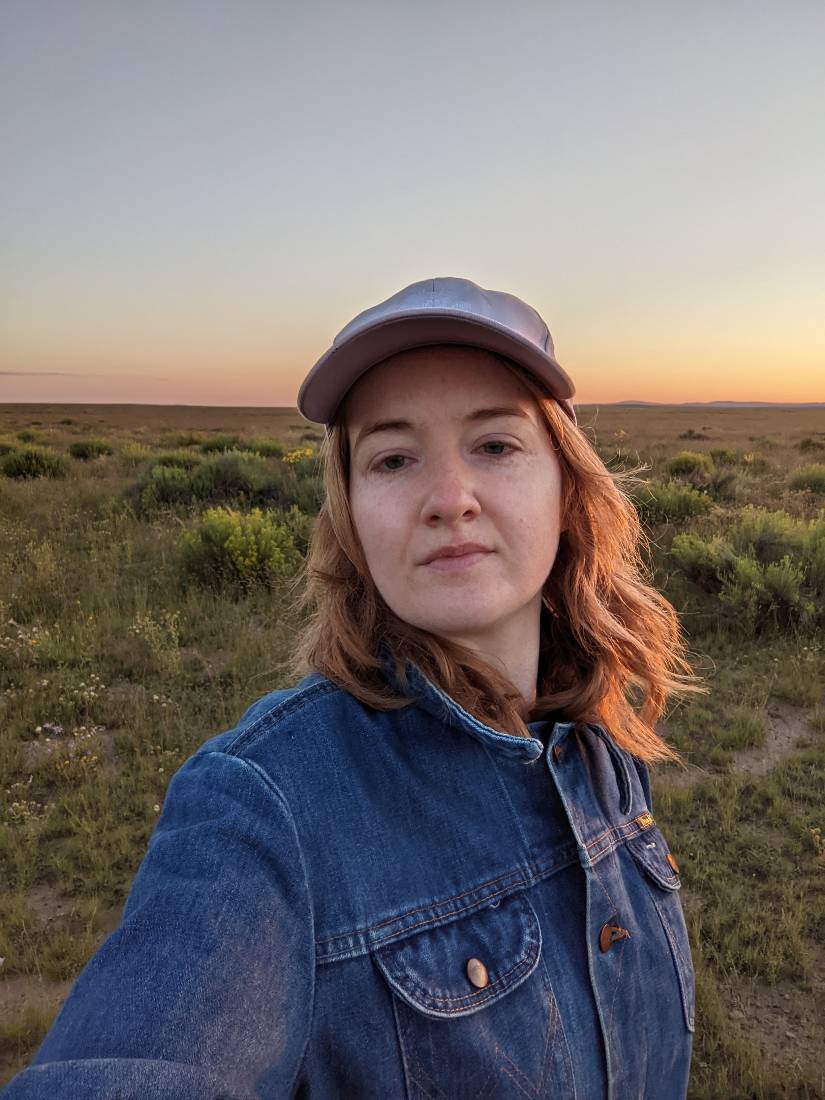"A Shadow on A Shadow": Lindsey Webb reviews "UNDERSHORE" by Kelly Hoffer (Lightscatter Press, 2023)
Posted on October 1, 2023
UNDERSHORE by Kelly Hoffer. Salt Lake City, UT: Lightscatter Press. 87 pages. $19.
Anna Atkins, whose beautiful cyanotypes of plants are some of the earliest examples of the art form, said that cyanotypes enabled her to capture “impressions of the plants themselves” in great detail, despite their fragility. After placing plants on photosensitive paper, exposing both to sunlight, and then developing the exposures in water, Atkins’ prints appear as white ghosts floating in a brilliant blue field. They are literal records of shadows.
One of Anna Atkins’s cyanotypes wraps around the cover of Kelly Hoffer’s UNDERSHORE, published in 2022 by Lightscatter Press. Amongst Hoffer’s poems are QR codes—looking themselves like dappled shadows—leading to images of cyanotype squares, also made by the poet. Hoffer’s cyanotypes contain botanical prints of her own, alongside scraps of language, and squares and triangles of shadow. Viewed as a group, each square suggests traditional quilt block patterns—fittingly, these cyanotypes were sewn into a paper quilt that Hoffer brought along on many stops of her book tour. UNDERSHORE, as you can perhaps already imagine, is rich in media and rich with resonance. The lines between material and ineffable things—between shadow and object, light and paper, breath and fabric, digital and material, needle and paper—slip and hitch throughout the collection, and I am left with the lingering impression of, well, impressions. The acts of pressing, imprinting, shadowing, and piercing recur across the poems, mirrored in their visual supplements. UNDERSHORE tracks these alongside other, more ineffable marks others leave upon us and the world when they go.
In UNDERSHORE, many threads are available for pulling. Here, the one I’ve picked up is the sequence of poems each entitled “Visitation,” which are scattered throughout the expansive collection. The “Visitation” poems narrate appearances, across dreams and half-memories, of the speaker’s mother, who is dead. This mother figure is always on the brink of slipping away or occupied with strange tasks. Her status is uncertain, unstable—she is busy, moving in the present, yet she is not living. It is as if these poems, too, are attempting to record a shadow. Yet this shadow is not merely the dark shadow of grief, but something brighter, something like an afterlife of the speaker’s mother. Hoffer writes:
where is she drifting
in my white or is she just
the darkness
a shadow on shadow, a place my mind
blotted out
in the recess of the sun. (26)
The mother figure reappears across UNDERSHORE as an impression—that is, not as a stable narrative character or even a stable vector for memory, but as a figure that literally makes impressions. She “traces an oval on a wax tablet” (33), “break[s]” a “film” of water “over the ridge of her nose” (34), “open[s] / bread” and “pulls a hyacinth from the center” (46), “breathes out and sees it, / her lung / ghosted in front of her / dissipating in the print / of the cows’ mouths” (66). In the continuous present of the visitation, the mother is pressing, lifting, touching, marking anew the world despite having left it. The speaker seems to follow behind, marking and reading marks, cataloging needles that pierce layers of the world in order to sew them together: “it’s a needle still / the cloud” (70); “brightening desire pokes heat… concave places, carving / a countenance (wait while I count)” (29). It is as if the poems are the blue upon which the mother’s white shadow is continually, sometimes painfully, impressed.
The central mystery of these poems lies in this question: how does a person continue to mark the world despite having left it? The afterlife UNDERSHORE traces is not a Christian one of heaven and hell: one poem describes “my mother and her Mary, / who I can’t believe in” (70), and another: “we didn’t want any baptisms, didn’t want any blessings” (75). Yet, in a poem entitled “Office of the Holy Face,” the speaker says: “I need that good relic / a portrait possessed by a flickering. tallow-light / an exercise to think her body dead and alive” (44). The Catholic relic acquires a second, material life after the saint’s death: being prayed over, traveled to, encased in beautiful frames, and touched. Hoffer’s speaker, who cannot abide the religious relic, is nevertheless after “that good relic / a portrait possessed by a flickering.” Does art, as the poem hints, provide one kind of borrowed immortality? UNDERSHORE pulls at these questions but is not satisfied with the easy answers they imply. Material decays, and even the most durable material left behind by a loved one does not, of course, rescue them from having died. Hoffer’s “good relic” seems closer to a shadow left behind by the dead, a memory of an impression—as fragile as a quilt, “blurr[y]” as “a mist in a glass case” (71), yet resolutely material: not alive but also not quite dead. A pale silhouette, captured, but only ever imperfectly and incompletely.
UNDERSHORE ends with a final “Visitation” poem and, perhaps, an example of a “good relic.” The speaker’s mother
alights on the surface bevel
and preens the loose threads
from my sampler. She continues
pulling seeds from a stitched
rose, disintegrating to become
a nest. (87)
A rose of carefully placed stitches suddenly bears seed under the mother’s fingers. And, at the same time, the embroidery sampler’s display of order and mastery—designed to showcase all the types of stitches one has perfected in a single piece—is unpicked. But instead of chaos, the mother has created a nest. Or, perhaps, the mother is the nest. The poem’s lost referent in the last few lines—is it the rose disintegrating, or the mother?—leaves this blurred, ambiguous. I’m reminded of Bachelard’s discussion of the nest in The Poetics of Space, a dwelling made by the repeated impression of the bird’s breast into the assembled mud and grass. The bird turns, presses, turns, presses again. The nest, a work which bears the imprint of the particular bird who made it, who sculpted it with the impression of its passing body, is a kind of art requiring great attention and purpose but eschewing mastery. In some cases, it can long outlive the bird. The nest certainly outlives the season of its breeding it was made to be useful for. What’s left behind is a fragile, unstable relic, not unlike a cyanotype, or a poem: a mark that contains within its very form a pattern of its fleetingness.

Kelly Hoffer is a poet and book artist. Her debut collection of poetry, UNDERSHORE (2023), was selected by Diana Khoi Nguyen as the winner of the Lightscatter Press Prize. The manuscript of her second collection, "Fire Series," was a finalist for the 2021 National Poetry Series and the Georgia Poetry Prize. Her poems have appeared or are forthcoming in Gulf Coast, TAGVVERK, American Chordata, Denver Quarterly, Mississippi Review, Prelude, and Second Factory among others. Her essays and reviews have appeared or are forthcoming in Cultural Critique, Henry James Review, Inscription, Jacket2, and Post45. She currently teaches in the MFA program at the University of Michigan as the Helen Zell Visiting Professor in Poetry. Learn more at https://www.

Lindsey Webb is the author of Plat (Archway Editions, forthcoming 2024), and the chapbooks House (Ghost Proposal, 2020) and Perfumer's Organ (above/ground press, 2023). Her writings have appeared in Chicago Review, Denver Quarterly, jubilat, and Lana Turner, among others. She lives in Salt Lake City, where she is a Clarence Snow Memorial fellow and PhD candidate in Literature and Creative Writing at the University of Utah.